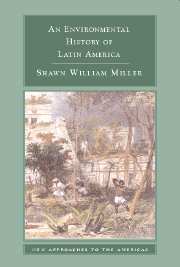Book contents
- Frontmatter
- Contents
- List of illustrations
- Acknowledgments
- Map 1 Middle America
- Map 2 South America
- Introduction: Props and Scenery
- 1 An Old World Before It Was “New”
- 2 Nature's Conquests
- 3 The Colonial Balance Sheet
- 4 Tropical Determinism
- 5 Human Determination
- 6 Asphyxiated Habitats
- 7 Developing Environmentalism
- Epilogue: Cuba's Latest Revolution
- Suggested Further Reading
- Index
Introduction: Props and Scenery
Published online by Cambridge University Press: 05 February 2015
- Frontmatter
- Contents
- List of illustrations
- Acknowledgments
- Map 1 Middle America
- Map 2 South America
- Introduction: Props and Scenery
- 1 An Old World Before It Was “New”
- 2 Nature's Conquests
- 3 The Colonial Balance Sheet
- 4 Tropical Determinism
- 5 Human Determination
- 6 Asphyxiated Habitats
- 7 Developing Environmentalism
- Epilogue: Cuba's Latest Revolution
- Suggested Further Reading
- Index
Summary
Without contradiction, this land is the best of all for the life of man: the air is exceptionally healthful, and the soil extremely fertile; all that is before you is delightful and pleasing to the human eye to a great degree.
In 1519, Hernán Cortés advanced on Aztec Mexico to accomplish the foremost event of America's conquest. Launching from Cuba, his armies sailed the coral reefs of Cozumel, marched through rainforests in Vera Cruz, skirted smoking volcanoes in the Sierra Madre, and crossed the reflective lakes of the Valley of Mexico, some of the earth's most stunning and diverse geography. Remarkably, the conquistadors had very little to say about the nature they encountered along their paths to empire. Nature was unacknowledged, taken for granted. The conquest's chroniclers – Cortés, Francisco López de Gómara, Bernal Díaz del Castillo – emphasized, rather, the subjugation of an exotic American culture, an antagonist whose story and defeat were worthy of the telling. American nature, it was assumed, had already been conquered by Amerindian cultures. America's human empires might resist for a time, but nature would supinely yield her possessions immediately upon the transfer of imperial title to her new rulers.
Cortés and his men shared a limited although all too common view of history, one in which men of professed superior culture, technology, and religion succeed one another in an unbroken chain as rulers of civilization.
- Type
- Chapter
- Information
- An Environmental History of Latin America , pp. 1 - 7Publisher: Cambridge University PressPrint publication year: 2007



